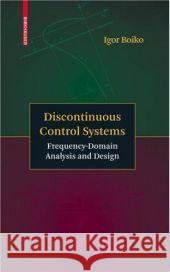Discontinuous Control Systems: Frequency-Domain Analysis and Design » książka
Discontinuous Control Systems: Frequency-Domain Analysis and Design
ISBN-13: 9780817647520 / Angielski / Twarda / 2008 / 212 str.
Discontinuous control systems are the oldest type of control system and the mostwidespreadtypeofnonlinearcontrolsystem. Thetheoryofdiscontinuous control, and the theory of relay feedback systems in particular, is usually c- sidered a mature subject. However, many problems in discontinuous control theory still remain open. One problem involves the input-output properties of these systems, knowledge of which is extremely important to every app- cation. Two types of discontinuous control systems are studied in this book. The ?rst is the so-called relay feedback system, which normally encompasses - lay servomechanisms, various on-o? controllers, sigma-delta modulators, relay feedback tests used for process dynamics identi?cation, and controller tuning. Relaysystemsareoftenconsideredthemaintypeofnonlinearsystem, whichis evident by the enormous amount of house temperature control systems (that are usually implemented as on-o? controllers) that exist. The theory of relay systems is an old subject. The problem of analysis of relay feedback systems was ?rst considered by L. MacColl in 1945 71]; the study was motivated by thedevelopmentofrelayservomechanismsofmissilethrustersontheonehand and vibrational voltage regulators on the other. MacColl s analysis was based on an approximate approach close to the describing function method. Later, exact methods of analysis of relay feedback systems were developed, the most well-known of which is the Tsypkin locus 94]. The exact approach developed by Tsypkin, however, did not consider the servo aspect of relay feedback c- trol. Its purpose was limited to ?nding periodic motions that may occur in a relay system in an autonomous mode or under external excitation."











